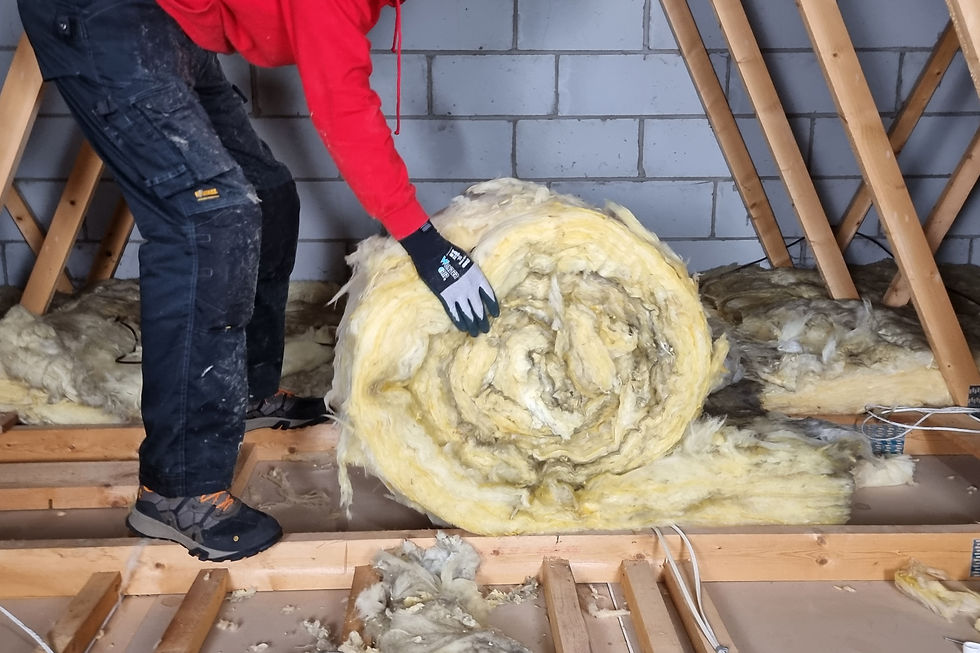5 Ways to Insulate Your Loft Correctly in 2020
- Matthew Driver
- Apr 27, 2020
- 3 min read
Updated: Dec 5, 2024

Are you looking to insulate your loft? Wondering where to begin and what is the best performing insulation for your home?
If so, you've come to the right place. Today, we're going to discuss all the different types of loft insulation you can use for your new setup. Read on to learn more!
Loft Insulation
While we discuss the different kinds of insulation, you should consider the thermal performance of each one. Insulation uses an R-value rating to show how effective it will be for a loft or home, the higher the R-Value the better the insulation
1. Blanket and Rolls

An inexpensive and DIY project, blanket, batts and rolls are types of insulation that are typically made from glass-fibres. This kind of insulation is designed to fit in between and above joists and roof trusses and even within walls, making it very easy to work with!
The roll type may need to be cut to width or length to ensure it fits correctly; however, this can be done with a simple utility knife with ease.
The standard R-value for this insulation is between 2.9 and 3.8.
A total depth of 270mm of this insulation in the loft will provide a U-Value of 0.16, the current government recommended value for a loft.
This type of insulation is ideal for homeowners looking to use their loft for occasional storage. If you plan to use the loft for storage then do not squash the insulation as this will affect its performance, raised loft boarding will be required (link to how to board your loft blog).
2. Spray Foam

This type of insulation is sprayed onto the underside of the rafters and will seal any air leaks or gaps in your roof. It's a liquid polyurethane that expands and hardens into a solid foam.
There are two different types of spray foam: open-cell and closed-cell. Open-cell foam values are typically 3.7 whereas closed-cell foam has a much higher rating of around 6.2, but it's much more expensive!
This type of insulation is ideal for homeowners looking to use their loft as a habitable room as it is applied to the underside of the roof (creating a warm room) rather than at floor level. It is a top choice for good quality insulation for your loft but can be pricey and needs to be installed by a professional.
3. Blown-in

Using a machine to blow a paper-like material in, blown-in insulation is made of fiberglass just like the blanket rolls but will typically use newspapers or cardboard as well.
This makes it extremely easy to conform to fit in any space that will need insulating and is extremely quick to install. Although this is typically a job for the professionals it can be a DIY type project. However, you will need to rent specialist equipment and once complete it will be difficult to use your loft for storage. Most homeowners will seal the loft hatch and never use the loft except for maintenance or essential access.
The R-values lists for blown-in usually range around 2.2 and 3.8.
4. Boards and Panels

Foam boards and rigid foam panels greatly reduce heat conducted through walls and the roof. This makes foam boards perfect to use when converting a loft to a habitable room.
They're R-values tend to be higher than other types and are usually between 4.0 and 6.
The boards are however very expensive, so if you are using your loft for occasional storage other methods will be better suited.
5. Loose Fill

Similar to blown fibre, this insulation uses loose, lightweight, material, such as cork granules, cellulose fibre, mineral wool or recycled newspaper.
It's easy to handle and can be a DIY project however calculating the exact R value is not straight forward and the thermal performance can be unpredictable !
It is also prone to movement once it has been laid down and the depth of the insulation csan be determined by the structure.
Which One Should You Choose?
The type of insulation you'll need for your new loft depends on a few different factors:
• Your requirements of your loft (habitable room or storage)
• Conditions in your loft
• Cost of the insulation
• DIY or hire a professional
Once you answer those questions, you'll be able to narrow down which loft insulation would be best for you!
If you're insulating your loft for storage and need more information about purchasing or installation, head over to our contact page and send us a message!



Two problems with spray foam insulation.
1) Some mortgage companies are starting to refuse to lend on properties with spray foam installed.
2) Spray foam can trap moisture in the roof timbers (even the open cell stuff). This leads to rot setting in and a potentially expensive repair bill.